Modifications to Mainsheet
Fairlead on the
Phantom Yacht
One of
the most important controls for a sail is the clew adjustment.
It's primary function is to control the draft in the sail by
moving it along the boom - towards the mast will increase the
draft increasing drive (and heeling force) but at the expense of
pointing - away from the mast decreases draft decreasing drive
(and heeling force) but enabling it to point higher. In
addition in the Phantom as initially set up with a fixed vang,
it can be used to adjust the twist in the sail by increasing or
decreasing how much the clew is pulled towards the boom.
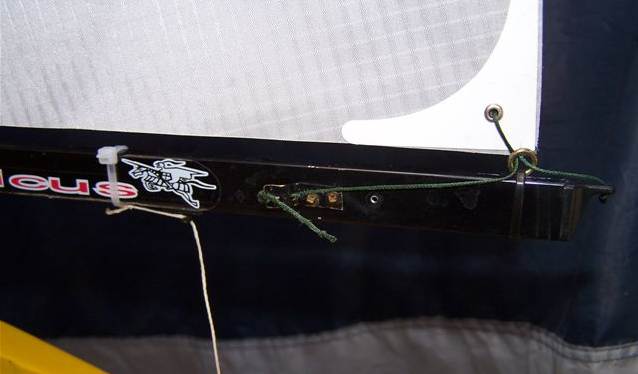 The
simplest arrangement I have seen is that done by Richard G.
Does this explain his excellent boat speed? Maybe!
The
simplest arrangement I have seen is that done by Richard G.
Does this explain his excellent boat speed? Maybe!
Examining this close up shows the two adjustments each
independent of of the other. Moving the cable tie
(how good are they!) and ring along the boom adjusts only the
draft as the loop of line through the clew moves with it leaving
the height the clew is above the boom constant so leaving the
sail twist (leech tension) constant. Adjusting the line
but leaving the cable tie in position adjusts the leech tension
hence sail twist while leaving the draft constant. In
addition, when changing sails to 'B' rig the line is easily
released and fed back through the new sail clew.
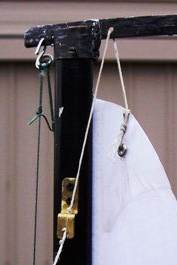 Notice
that Richard has also replaced the original fitting to tie off
the liner with a brass stepped fitting or cleat. The cleat
has a hole through which the line passes and a slot into which
the line lays. A series of knots in the line allows for
adjustment.
Notice
that Richard has also replaced the original fitting to tie off
the liner with a brass stepped fitting or cleat. The cleat
has a hole through which the line passes and a slot into which
the line lays. A series of knots in the line allows for
adjustment.
This is
not essential for the above process to work as the original
fitting will work fine or a bowsie or even another cable tie
would also work.
Ben's method uses wire bent around the boom so it can slide
along it with two hooks one to go through the sail clew and the
other to sit in holes drilled in the top of the boom 2mm apart.
This last hook is held in place by a cable tie which slides over
the wire and holds the hook in place.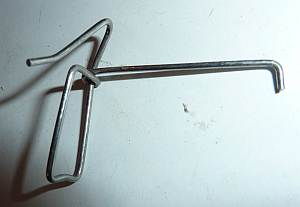
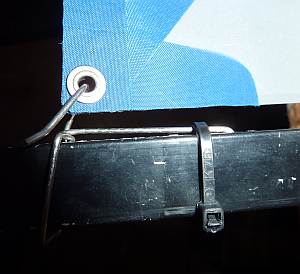
To
assist in the changing of rigs, all corners of the mainsail must
be adjustable and readily reset with the new sail. The
tack is most easily done with a metal hook such as a fishing
clip and bowsie for adjustment (picture to come soon). To
facilitate the replacement of the lines at the head of the sail
it is easiest if a larger hole is available in the mast crane or
a ring supported below the crane to readily feed the line which
tensions the sail luff through.
 The 'B'
rig jib replacement is easier in some ways as it comes with its
own boom and its associated sail adjustments using bowsies or
cable ties. The tricky part is in making the jib sheet
readily fixed to and removed from either boom. One way is
to use a fishing clip on a short loop attached to the boom by a
cable tie allowing ready adjustment by sliding the cable tie
along the boom and easy removal of the sheet with the fishing
clip.
The 'B'
rig jib replacement is easier in some ways as it comes with its
own boom and its associated sail adjustments using bowsies or
cable ties. The tricky part is in making the jib sheet
readily fixed to and removed from either boom. One way is
to use a fishing clip on a short loop attached to the boom by a
cable tie allowing ready adjustment by sliding the cable tie
along the boom and easy removal of the sheet with the fishing
clip.
The jib
clew is best done by two loops of cord - one fixed that holds
the sail clew down near the boom and one which loops around the
end of the boom and back to a loop held in place by a cable tie.
The cable tie can be slid along the boom to adjust the foot
curvature
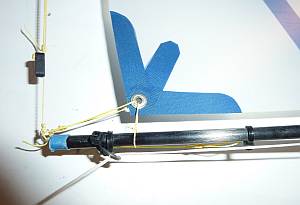
Note the
topping lift on the jib boom - an essential addition to all jibs
to allow the slot to be adjusted when the wind isn't strong
enough to blow it out.
page
last edited on
04/05/2025